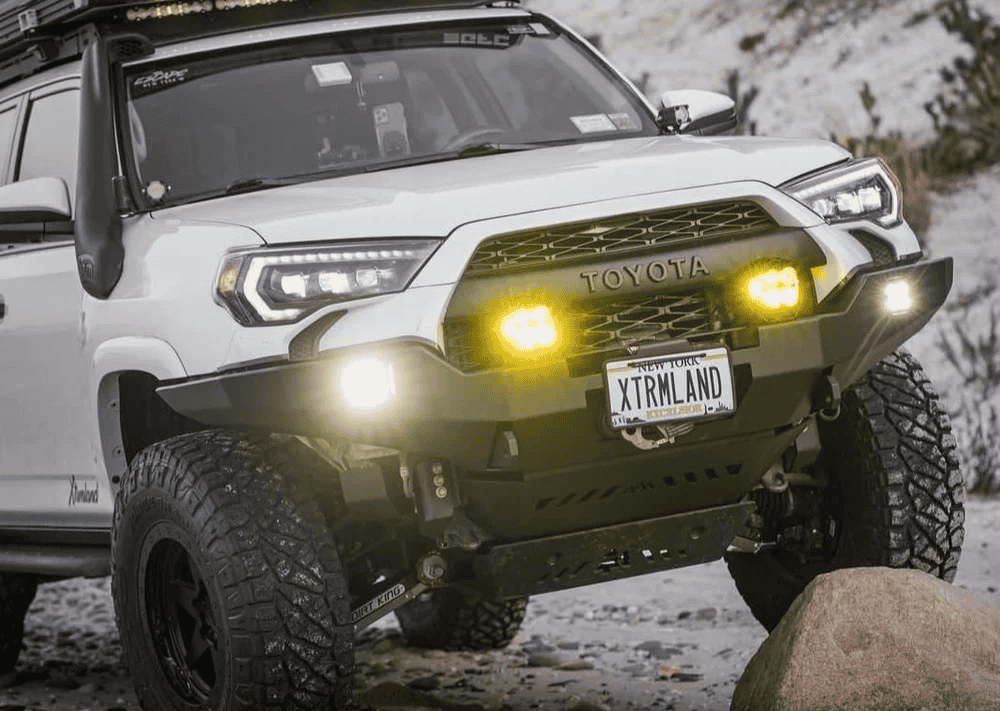Overland Vehicles

Start with the gross vehicle weight rating on the door label. Subtract the curb weight to find the rated payload. Remember that curb weight may not match your actual base weight if the vehicle already has accessories installed. Next, check the front and rear axle ratings. You must respect both the total limit and each axle limit at the same time.
Curb weight is the base vehicle with fluids and no cargo. Payload is everything you add. A family of four, a full drawer system, a second battery, and 10 gallons of water can consume hundreds of pounds fast. Water weighs about 8.34 pounds per gallon. Gasoline is about 6 pounds per gallon, and diesel is closer to 7. Add a winch, steel bumper, roof tent, and a full fridge, and you can approach the limit before you even pack clothing.
Roof load matters. Manufacturers publish dynamic roof ratings, which apply while driving. Static ratings, used for parked roof tents, are higher but do not change the legal payload or handling while moving. Towing adds another layer. Conventional hitches typically put 10 to 15 percent of trailer weight on the vehicle as tongue weight, and that number is part of payload. Add it to your total and confirm it does not overload the rear axle.
Use a certified public scale to see where you stand. Weigh the whole vehicle with passengers and full trip gear. Then weigh each axle. Compare those numbers to the gross and axle ratings. This tells you whether you need to shift cargo, change tire load index, or adjust your plan.
Fill the tank and pack as if you are leaving for a multi day trip. Weigh both axles together to get the total. Then roll forward and weigh only the front axle, then the rear axle. This reveals distribution and helps you spot an overloaded rear. If the rear is close to its rating, move heavy items forward and lower. Keep mass between the axles whenever possible to improve stability.
Weight location affects control as much as the number on the scale. High loads increase body roll and reduce grip on uneven surfaces. A lower center of gravity makes the vehicle more predictable in crosswinds and on off camber trails. Smart packing is a performance upgrade you can do for free.
Choose tires with a load index that meets or exceeds the axle ratings at the pressures you will actually run. Higher inflation increases capacity up to the tire maximum rating, but ride quality and traction also change, so test your setup. Upgraded springs, tuned shocks, and air helpers can improve sag, comfort, and control, yet they do not change the legal gross or axle ratings. Those limits come from the whole system, including the frame and brakes.
Consider seasonal changes. Winter clothing and heaters add weight. In desert travel, water is the big hitter, so plan resupply or filtration to avoid hauling excessive reserves. A 20 pound difference here and a 30 pound improvement there add up. Keep a simple spreadsheet of your kit. Weigh items with a luggage scale and build a running total so surprises do not sneak in the week before you leave.
Build a margin for the unknown. Trails evolve after storms and snowmelt. Deep sand and slick clay put heavy demands on tires and drivetrain, and an overloaded truck sinks and overheats sooner. Carry only the recovery gear you know how to use. Two traction boards, a rated soft shackle, and a compatible snatch strap solve most problems without unnecessary mass.
If you tow, verify the trailer is balanced with about 12 percent tongue weight for stability, confirm the hitch class rating, and ensure the trailer brakes are set correctly. Poorly distributed trailers sway, unload the front axle, and lengthen stopping distances. A simple scale at the tongue shows if you are in the safe range.
For vans and long wheelbase platforms, track how cabinetry, water tanks, and batteries stack up. Place dense items low and near the centerline. Ventilated brake upgrades and appropriate gear ratios may help in mountains, but they still do not raise the official ratings. The safe plan is to load within limits, then tune the ride.
Bold ideas thrive when they are grounded in numbers. When you know your real weights and the path to balance them, overlanding becomes smoother, quieter, and far more reliable.
Strong builds start with a clear plan. If you want a rig that carries its load with confidence, explore our overland builds and design approach on the overland rigs page at overland rigs. For tailored layouts, materials, and systems that protect handling and payload, see our custom overland upfit. Curious how we work and why travelers trust us, visit why choose OZK Customs.
Precision matters. Share your travel style, crew size, and gear list, and we will turn the numbers into a balanced layout that keeps you within ratings while adding comfort and capability. Our team builds rigs that feel planted on the highway and composed on washboard, with storage that makes sense and power systems sized to your trips. Tell us where you want to go, and we will help you get there with room to spare.
Ready to build a capable rig without guessing on weight. Tell us how you travel, and our team will map payload, balance your layout, and upfit the right components for control, comfort, and safety. Share your trip goals and we will start a precise plan today.
ADDRESS:
6159 E Huntsville Rd, Fayetteville, AR 72701
PHONE:
(479) 326-9200
EMAIL:
info@ozkvans.com